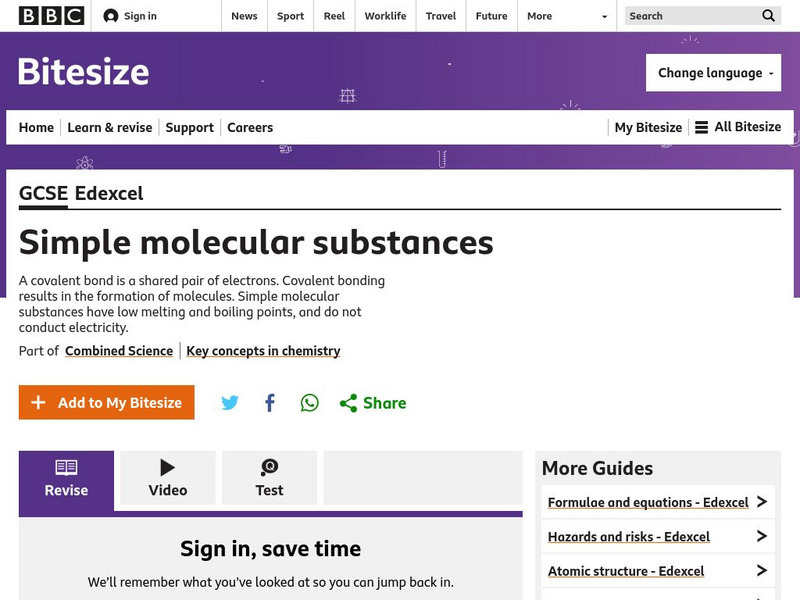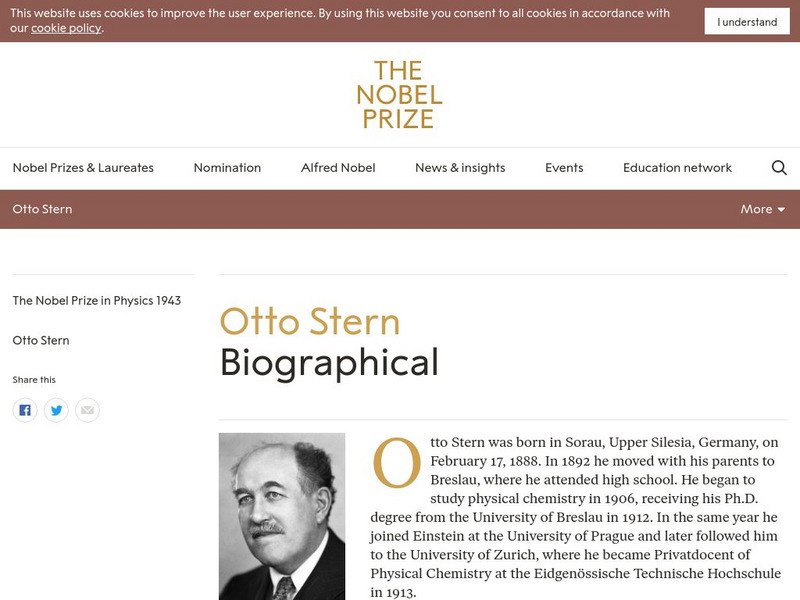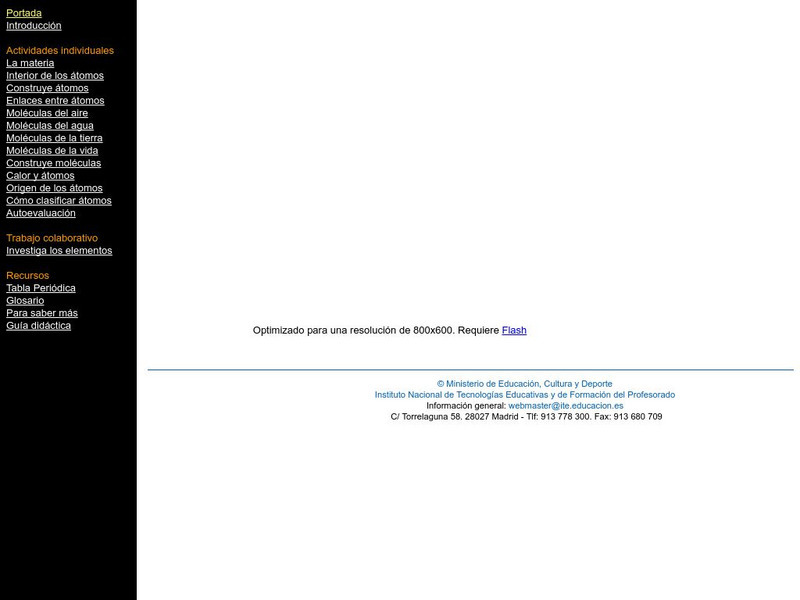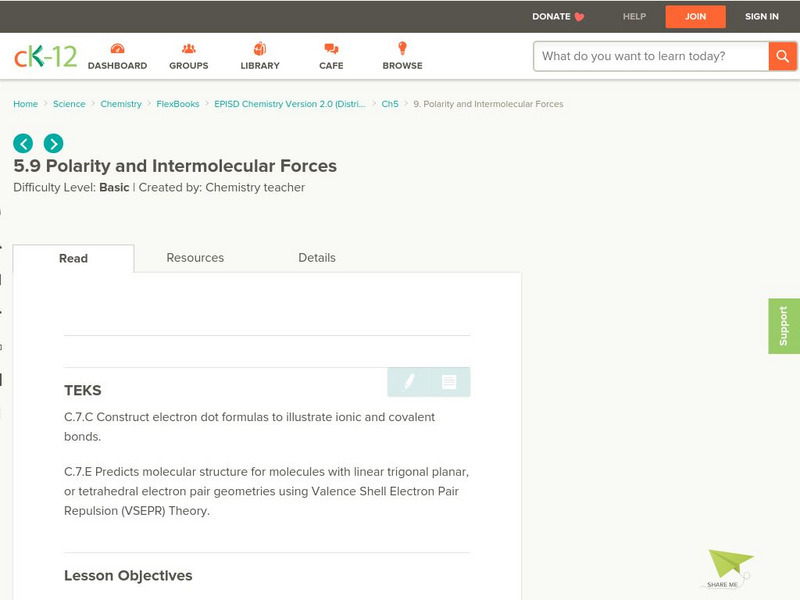TED Talks
Ted: Ted Ed: What Is the Universe Made Of?
The atoms around you have existed for billions of years- and most originated in the flaming, gaseous core of a star. Dennis Wildfogel tells the captivating tale of these atoms' long journeys from the Big Bang to the molecules they form...
The Wonder of Science
The Wonder of Science: Ms Ps1 1: Atomic Composition Model
A collection of lesson plans for helping students understand atomic composition. Site uses work samples, phenomena, assessment templates, and videos to plan lessons to describe the atomic composition of simple molecules.
Concord Consortium
Concord Consortium: Nonbonding
Bring two molecules together and observe potential energy changes.
CK-12 Foundation
Ck 12: Life Science: 2.1 Elements and Compounds
Learn how basic elements form molecules to support life.
BBC
Bbc: Gcse Bitesize: Covalent Bonds
A covalent bond is formed between non metal atoms, which combine together by sharing electrons. Covalent compounds have no free electrons and no ions so they don't conduct electricity.
Concord Consortium
Concord Consortium: How Can a Small Spark Start a Huge Explosion?
In this module Activity 2 investigates What holds the atoms of a molecule together?The activity will explore what holds atoms together and why they from a molecule. Bonus reading includes Same Molecules but Different Representations.
Other
Science Alive: Synthetic vs. Natural: What's the Difference?
Through this reading, young scholars will learn that a substance's properties arise from its molecular structure, not from how it's made (i.e., synthesized by people or found in nature). There is no fundamental difference between natural...
Nobel Media AB
The Nobel Prize: Otto Stern Biographical
This is a brief biography on the life and scientific work of Otto Stern, a physicist honored with the Nobel Prize in physics for his "development of the molecular ray method and his discovery of the magnetic moment of the proton."
Wikimedia
Wikipedia: Ion
This site is an encyclopedia article from the Wikipedia Encyclopedia on Ion. Throughout the site, links are provided for additional information. The information is somewhat in-depth, but also very factual and interesting.
Concord Consortium
The Concord Consortium: Molecular Workbench: Pendulum, Slider, and Spring
Observe the motion of this animated system to represent an analogy for molecular mechanics of atoms and molecules.
ClassFlow
Class Flow: Comparing and Contrasting Matter
[Free Registration/Login Required] This flipchart is a guided activity to help students compare different types of matter: atoms and molecules, elements and compounds, mixtures and solutions. It corresponds to Virginia science SOL 5.4.
Ministerio de Educación (Spain)
Ministerio De Educacion: Viaje Al Interior De La Materia
These interactive materials will help you to understand how matter is made up and will help you expand your knowledge on matter. You will find an evaluation at the end.
State University of New York
State University of New York: Determining Electron Pair Geometry
The electron-pair geometry of a molecule or ion depends on the number of structurally significant electron pairs in the central atom. Here students are asked to count the number of lone electron pairs and bonded atoms on the central...
ClassFlow
Class Flow: What Is Matter?
[Free Registration/Login Required] Discover the composition of matter and the relationship between matter, atoms, and elements. Students will learn the differences between elements and compounds, and how molecules are formed. Chemical...
Ducksters
Ducksters: Chemistry for Kids: Chemical Bonding
Study chemical bonding in chemistry including atoms, valence electrons, ionic and covalent bonding, and how molecules are formed on this site!
Ducksters
Ducksters: Chemistry for Kids: Organic Chemistry
Kids learn about organic chemistry including the importance of carbon, organic molecules, compounds, hydrocarbons, synthesis, and functional groups.
Other
Science Alive: What Is Organic Chemistry?
This reading/lesson plan introduces young scholars to the concept of organic chemistry.
Utah STEM Foundation
Utah Stem Action Center: Smoke in a Bottle
Students will learn how complete and incomplete combustion is different and also how the products affect us.
Bill Nye
Bill Nye: Hole Y Water
Try this at-home science experiment to learn that a glass of water molecules contains a whole lot of space.
Curated OER
Simon Fraser University: Molecules and the Properties of Bonded Atoms
Benzene animation, showing some vibrational modes.
Science Buddies
Science Buddies: Study Chirality With a Homemade Polarimeter
Some molecules can be either left- or right-"handed." The left- and right-handed molecules have the same number and type of atoms, and their chemical structures look identical, but they are actually mirror images of each other. Many...
Chiral Publishing
Chiral Publishing: An Introduction to Chemistry: Oxidation Reduction Reactions [Pdf]
Read about how oxidation-reductions affect our everyday lives. View how atoms, molecules, and ions are reduced during the oxidation-reduction process. Learn how some of the normal chemical reactions in the body can change DNA. Use the...
CK-12 Foundation
Ck 12: Polarity and Intermolecular Forces
[Free Registration/Login may be required to access all resource tools.] The following online tutorial describes how the electronegativity difference between two atoms in a covalent bond results in the formation of a nonpolar covalent,...
OpenStax
Open Stax: Andrew R. Barron: Valence Shell Electron Pair Repulsion (Vsepr) Theory
Detailed explanation of Valence Shell Electron Pair Repulsion (VSEPR) Theory with examples and questions for the reader to check comprehension. Also includes step-by-step instructions for correctly building molecules using VSEPR Theory....
Other popular searches
- Gumdrop Atoms and Molecules
- Counting Atoms Molecules
- Making Atoms and Molecules
- Atoms & Molecules Ppt
- Matter Atoms Molecules
- Science, Atoms and Molecules
- Science Atoms and Molecules
- Atoms Molecules Elements
- Atoms & Molecules Pot
- Atoms and Molecules Lesson
- Atoms Molecules Units
- Atoms and Molecules Musical

















